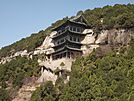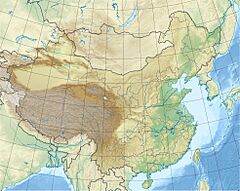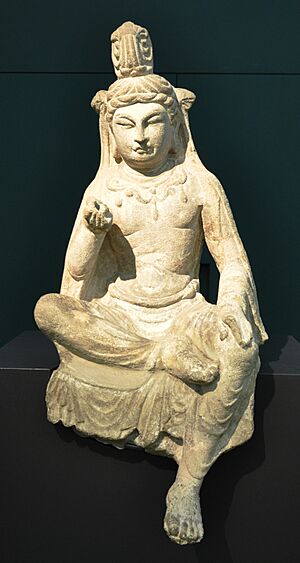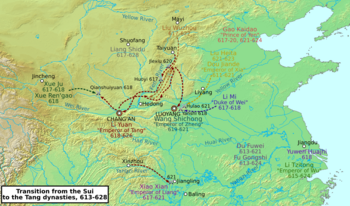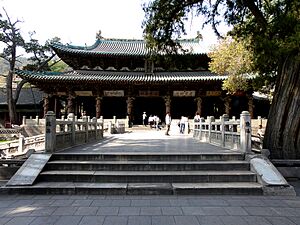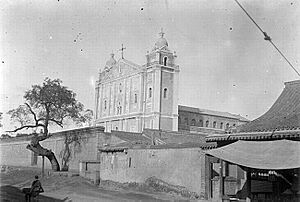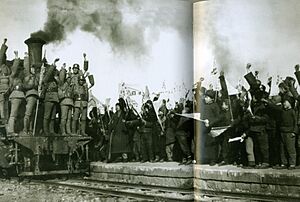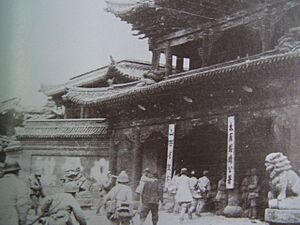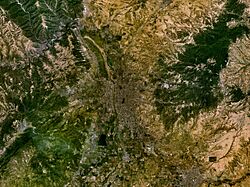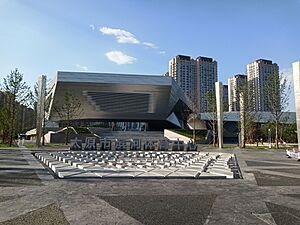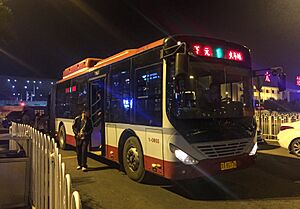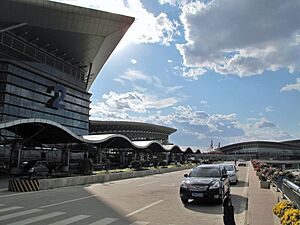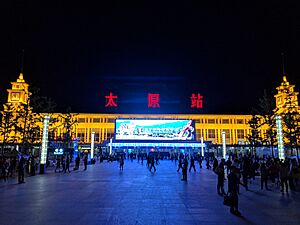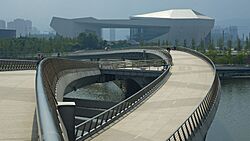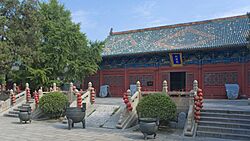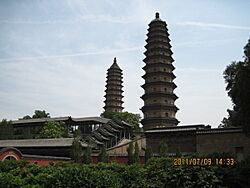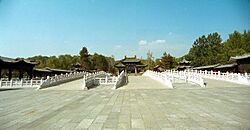Taiyuan facts for kids
Quick facts for kids
Taiyuan
太原市
|
|
|---|---|
|
Prefecture-level city
|
|
|
From top down, left to right: Taiyuan skyline; Twin Pagoda Temple; Tianlongshan Grottoes; Two temples of Jinci
|
|
| Nickname(s):
Bīngzhōu (并州); Jìnyáng (晋阳); Dragon City (龙城)
|
|
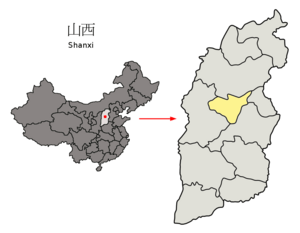
Location of Taiyuan City jurisdiction in Shanxi
|
|
| Country | China |
| Province | Shanxi |
| Municipal seat | Xinghualing District |
| Divisions | County-level divisions: 10, Township-level divisions: 83 |
| Government | |
| • Type | Prefecture-level city |
| • Body | Taiyuan Municipal People's Congress |
| Area | |
| • Prefecture-level city | 6,959 km2 (2,687 sq mi) |
| • Urban | 1,460 km2 (560 sq mi) |
| • Metro | 2,787 km2 (1,076 sq mi) |
| Elevation | 800 m (2,600 ft) |
| Highest elevation | 2,670 m (8,760 ft) |
| Lowest elevation | 760 m (2,490 ft) |
| Population
(2020 census)
|
|
| • Prefecture-level city | 5,305,061 |
| • Density | 762.33/km2 (1,974.43/sq mi) |
| • Urban | 4,529,141 |
| • Urban density | 3,102/km2 (8,035/sq mi) |
| • Metro | 5,433,659 |
| • Metro density | 1,949.6/km2 (5,049.6/sq mi) |
| GDP | |
| • Prefecture-level city | CN¥ 415 billion US$ 65.3 billion |
| • Per capita | CN¥ 78,284 US$ 12,570 |
| Time zone | UTC+08:00 (China Standard) |
| Postal code |
030000
|
| Area code(s) | 351 |
| ISO 3166 code | CN-SX-01 |
| Vehicle registration | 晋A |
| GaWC Global City level classification | Gamma - |
| Major Nationalities | Han |
| Administrative division code | 140100 |
| Taiyuan | |||||||||||||||||||||||||||||||
|---|---|---|---|---|---|---|---|---|---|---|---|---|---|---|---|---|---|---|---|---|---|---|---|---|---|---|---|---|---|---|---|

"Taiyuan" in Chinese characters
|
|||||||||||||||||||||||||||||||
| Chinese | 太原 | ||||||||||||||||||||||||||||||
| Literal meaning | "Great Plain" | ||||||||||||||||||||||||||||||
|
|||||||||||||||||||||||||||||||
Taiyuan is the capital city of Shanxi province in China. It is a very important city for Shanxi, serving as its main center for politics, economy, culture, and international connections. Taiyuan is also known for its industries, especially those related to energy and heavy chemicals. Because of its long history, Taiyuan has often been a capital city for many Chinese dynasties. This is why it's sometimes called Dragon City.
As of 2021, Taiyuan manages 6 districts and 3 counties. It also includes one county-level city. The total area of Taiyuan is about 6,988 square kilometers. Over 5.3 million people live there permanently. Taiyuan is located in the middle of Shanxi province. The Fen River flows right through the city.
Contents
- Understanding Taiyuan's Name
- Taiyuan's Rich History
- Taiyuan's Geography and Climate
- Taiyuan's Administrative Divisions
- Taiyuan's Population and Economy
- Getting Around Taiyuan
- Delicious Food in Taiyuan
- Sports in Taiyuan
- Exploring Taiyuan: Top Tourist Spots
- Education and Research in Taiyuan
- Taiyuan's International Connections
- See also
Understanding Taiyuan's Name
The name Taiyuan comes from two Chinese characters. Tài means "great," and yuán means "plain." This name describes the city's location. It's where the Fen River leaves the mountains and flows into a flat area.
Throughout history, Taiyuan has had other names. These include Bīngzhōu and Jìnyáng. It was also called Lóngchéng, meaning "Dragon City." During the Tang dynasty, Taiyuan was even known as the "Northern Capital." This was because it was one of China's three main capital cities.
Taiyuan's Rich History
Taiyuan is a very old city, with more than 2,500 years of history. It was founded in 497 BC. Over the centuries, Taiyuan served as a capital or important city for many different dynasties. Its location made it a key center for economy, politics, military, and culture in Northern China.
Early History of Taiyuan
Around 859 BC, the area was home to the Rong people. Later, in 662 BC, the Di people took over. The first ancient city, Jinyang, was built in 497 BC. It was built by Dong Anyu, an official from the state of Jin.
A big event happened in 453 BC during the Battle of Jinyang. An army tried to flood Jinyang by changing the Fen River's path. But the people of Jinyang, with help from allies, broke the dams. This flooded the attacking army instead. This battle led to the division of the Jin state into three smaller states in 403 BC. This event marked a big change in Chinese history.
Taiyuan in Imperial China
In 248 BC, the state of Qin took control of the area. They created the Taiyuan Commandery, with Jinyang as its center. This was the first time "Taiyuan" was officially used for this area. When the Qin dynasty united China in 221 BC, Taiyuan became one of its 36 main regions.
During the Jin dynasty and the Sixteen Kingdoms period, Taiyuan was part of many different states. It was a very important place that many groups wanted to control.
In 386, the Northern Wei dynasty expanded to include Taiyuan. Later, in 543, Eastern Wei made Taiyuan an important secondary capital.
Taiyuan's Role in the Tang Dynasty
The Sui dynasty began in 581. In 617, Li Yuan started a rebellion in Taiyuan. This rebellion led to the creation of the Tang dynasty in 618. The Tang dynasty is seen as a golden age for China. Taiyuan grew a lot during this time. It was a key military base for the first Tang emperors.
Empress Wu Zetian even made Taiyuan one of the three "Northern Capitals" in 690. This showed how important the city was.
Taiyuan Through Later Dynasties
After the Tang dynasty, Taiyuan continued to be a significant city. During the Five Dynasties and Ten Kingdoms period, it was often a provisional capital.
When the Song dynasty began, its first emperor tried to reunite China. He attacked Taiyuan, which was then part of the Northern Han kingdom. After a long fight, the Song army finally conquered Taiyuan in 979. The emperor ordered the city to be flooded and burned. A new city was built nearby in 982. The oldest building in Taiyuan today, the Temple of the Goddess in Jin Ci, was built during the Song dynasty.
The Jurchen Jin dynasty took Taiyuan in 1125. Later, in 1218, the Mongol army, led by General Muqali, conquered Taiyuan. When Kublai Khan started the Yuan dynasty in 1271, Taiyuan's administrative area became even larger.
In 1368, the Ming dynasty began. Taiyuan became one of the Nine Military Garrisons that protected China's northern borders. This period also saw the rise of famous Shanxi merchants.
During the Qing dynasty, Taiyuan became an important trading center. It was especially known for its tea trade with Russia. The city also played a role in the development of early Chinese banks, called Piaohao. In 1900, a sad event known as the Taiyuan Massacre occurred, where some Western missionaries lost their lives.
Taiyuan in Modern Times
From 1911 to 1949, a leader named Yan Xishan controlled Shanxi province. Taiyuan grew a lot during this time, becoming an industrial hub. It had advanced factories that could even make artillery. Yan Xishan worked to protect Shanxi from conflicts.
When the Japanese invaded China, Yan Xishan formed a secret alliance to defend against them. Taiyuan became a gathering place for people who wanted to fight against the Japanese. The Japanese army later said that the Chinese fought very bravely in Taiyuan. After the Japanese surrendered in 1945, many Japanese soldiers and technicians stayed to help Yan Xishan.
Taiyuan was the last part of Shanxi to be taken by the Communists during the Chinese Civil War. The city was captured on April 22, 1949, after a long siege.
Taiyuan's Geography and Climate
Taiyuan is located on the Fen River in the northern part of its fertile valley. The city is in the center of Shanxi province. It's a key point for travel, connecting north and south Shanxi. It also links to Hebei in the east and Shaanxi in the west through mountain passes.
Natural Resources in Taiyuan
Taiyuan is rich in natural resources. These include coal, iron, marble, and bauxite. It also has limestone, graphite, quartz, and gold. The city is known for producing a lot of coal, iron, and marble. Nearby Gujiao is China's biggest producer of coal used for making steel. The forests around Taiyuan are mostly made up of coniferous trees like pine and cypress.
Taiyuan's Weather Patterns
Taiyuan has a climate that changes a lot with the seasons. Winters are long, dry, and cold. Summers are hot and humid. Spring and autumn are short and often windy. The city experiences a cold semi-arid climate. This means it's quite dry.
The average temperature in January is about -4.7°C (23.5°F). In July, it's around 24.3°C (75.7°F). The yearly average is 10.9°C (51.6°F). Taiyuan gets about 2,493 hours of sunshine each year. The lowest temperature ever recorded was -25.5°C (-13.9°F). The highest was 39.4°C (102.9°F).
| Climate data for Taiyuan, elevation 776 m (2,546 ft), (1991–2020 normals, extremes 1951–2010) | |||||||||||||
|---|---|---|---|---|---|---|---|---|---|---|---|---|---|
| Month | Jan | Feb | Mar | Apr | May | Jun | Jul | Aug | Sep | Oct | Nov | Dec | Year |
| Record high °C (°F) | 14.3 (57.7) |
19.8 (67.6) |
28.3 (82.9) |
37.5 (99.5) |
37.7 (99.9) |
38.7 (101.7) |
39.4 (102.9) |
36.6 (97.9) |
34.9 (94.8) |
28.7 (83.7) |
23.2 (73.8) |
18.2 (64.8) |
39.4 (102.9) |
| Mean daily maximum °C (°F) | 2.3 (36.1) |
6.7 (44.1) |
13.3 (55.9) |
20.7 (69.3) |
26.3 (79.3) |
29.5 (85.1) |
30.3 (86.5) |
28.6 (83.5) |
24.2 (75.6) |
18.1 (64.6) |
10.1 (50.2) |
3.5 (38.3) |
17.8 (64.0) |
| Daily mean °C (°F) | −4.7 (23.5) |
−0.7 (30.7) |
5.9 (42.6) |
13.2 (55.8) |
19.0 (66.2) |
22.7 (72.9) |
24.3 (75.7) |
22.6 (72.7) |
17.4 (63.3) |
10.8 (51.4) |
3.2 (37.8) |
−3.1 (26.4) |
10.9 (51.6) |
| Mean daily minimum °C (°F) | −10.2 (13.6) |
−6.5 (20.3) |
−0.5 (31.1) |
6.0 (42.8) |
11.7 (53.1) |
16.2 (61.2) |
19.1 (66.4) |
17.8 (64.0) |
12.1 (53.8) |
5.1 (41.2) |
−2.0 (28.4) |
−8.1 (17.4) |
5.1 (41.1) |
| Record low °C (°F) | −25.5 (−13.9) |
−24.6 (−12.3) |
−18.0 (−0.4) |
−9.7 (14.5) |
−0.7 (30.7) |
4.4 (39.9) |
7.2 (45.0) |
7.4 (45.3) |
−2.0 (28.4) |
−13.9 (7.0) |
−21.2 (−6.2) |
−23.3 (−9.9) |
−25.5 (−13.9) |
| Average precipitation mm (inches) | 3.2 (0.13) |
4.7 (0.19) |
10.1 (0.40) |
22.1 (0.87) |
30.6 (1.20) |
47.9 (1.89) |
104.3 (4.11) |
102.5 (4.04) |
59.8 (2.35) |
29.6 (1.17) |
13.1 (0.52) |
2.6 (0.10) |
430.5 (16.97) |
| Average precipitation days (≥ 0.1 mm) | 1.7 | 2.4 | 3.2 | 5.4 | 6.0 | 9.6 | 11.4 | 10.7 | 7.6 | 6.1 | 3.2 | 1.6 | 68.9 |
| Average snowy days | 2.7 | 3.2 | 2.0 | 0.7 | 0 | 0 | 0 | 0 | 0 | 0.1 | 1.8 | 2.4 | 12.9 |
| Average relative humidity (%) | 51 | 47 | 44 | 45 | 46 | 57 | 69 | 73 | 71 | 66 | 59 | 52 | 57 |
| Mean monthly sunshine hours | 164.9 | 173.4 | 216.1 | 242.7 | 268.0 | 241.4 | 228.8 | 221.9 | 199.9 | 199.6 | 172.0 | 163.9 | 2,492.6 |
| Percent possible sunshine | 54 | 56 | 58 | 61 | 61 | 55 | 51 | 53 | 54 | 58 | 57 | 55 | 56 |
| Source 1: China Meteorological Administration | |||||||||||||
| Source 2: Météo Climat (records) | |||||||||||||
Protecting Taiyuan's Environment
Taiyuan has a total area of 6,988 square kilometers. It has a large forest area of 146,700 hectares. The city has worked to increase its forest cover, reaching 21.69% in its urban districts by 2015.
Improving Air Quality
Taiyuan used to have serious air pollution, especially in the 1990s and early 2000s. It was even listed as one of the most polluted cities in the world. However, the air quality has been getting better. This is thanks to more public awareness and stricter rules against pollution.
Studies show that many homes in Taiyuan still burned coal in 2016. To fight pollution, the city created a "coal-free zone" in 2017. This zone stops most people and groups from using coal. In 2019, this zone was made even larger. The city is working to switch from coal to cleaner energy sources like gas and electricity.
Taiyuan's Administrative Divisions
Taiyuan is divided into different areas for easier management. These include city districts, suburban areas, and rural counties.
| Map | ||||||
|---|---|---|---|---|---|---|

Xiaodian
Yingze
Xinghualing
Jiancaoping
Wanbailin
Jinyuan
Qingxu
County Yangqu
County Loufan
County Gujiao
(city) |
||||||
| Name | Simplified Chinese | Hanyu Pinyin | Population (2010) | Area (km2) | Density (/km2) | |
| City Proper | ||||||
| Xiaodian District | 小店区 | Xiǎodiàn Qū | 804,537 | 290 | 2,774 | |
| Yingze District | 迎泽区 | Yíngzé Qū | 592,007 | 105 | 5,638 | |
| Xinghualing District | 杏花岭区 | Xìnghuālǐng Qū | 643,584 | 146 | 4,408 | |
| Wanbailin District | 万柏林区 | Wànbǎilín Qū | 749,255 | 289 | 2,592 | |
| Suburban and satellite cities | ||||||
| Jiancaoping District | 尖草坪区 | Jiāncǎopíng Qū | 415,705 | 296 | 1,404 | |
| Jinyuan District | 晋源区 | Jìnyuán Qū | 221,431 | 290 | 763 | |
| Gujiao City | 古交市 | Gǔjiāo Shì | 205,143 | 1,512 | 135 | |
| Rural | ||||||
| Qingxu County | 清徐县 | Qīngxú Xiàn | 343,861 | 608 | 565 | |
| Yangqu County | 阳曲县 | Yángqǔ Xiàn | 120,228 | 2,084 | 57 | |
| Loufan County | 娄烦县 | Lóufán Xiàn | 105,841 | 1,289 | 82 | |
Taiyuan's Population and Economy
In 2020, Taiyuan had over 5.3 million people living in its prefecture. About 4.5 million of these people lived in the city's main urban districts.
Taiyuan's economy has been growing steadily. In 2018, its GDP (Gross Domestic Product) was 388.45 billion Yuan. This was more than double what it was in 2010. The average income for people in Taiyuan also increased. Shanxi province produces a quarter of China's coal. Taiyuan is home to the China Taiyuan Coal Transaction Center, which started trading coal in 2012.
Getting Around Taiyuan
Taiyuan is a major transportation hub in Northern China. It has highways connecting to nearby cities and flights to many major Chinese and some international cities.
Public Transport in Taiyuan
The Taiyuan Metro system is still being built. Line 2 opened in December 2020, and Line 1 is expected to open in 2024. In 2016, Taiyuan started changing all its 8,000 taxis to electric vehicles.
Air Travel from Taiyuan
The main airport is Taiyuan Wusu International Airport. It has flights to major Chinese cities like Beijing and Shanghai. There are also international flights to places like Taipei and Da Nang.
Taiyuan's Road Network
Taiyuan has many important roads. These include major expressways like G5, G20, and G55. A 45-kilometer Middle Ring Highway goes around the city. There are also highways along the Fen River and its branches. These roads help connect the city center with its surrounding areas.
Rail Connections in Taiyuan
Taiyuan is a key hub for China's high-speed railway system. High-speed trains can get you from Taiyuan to Beijing in less than three hours. The main high-speed train station is Taiyuan South railway station. There are also regular train lines connecting Taiyuan to western Shanxi and other regions.
Delicious Food in Taiyuan
Taiyuan has many unique local dishes. Here are some of them:
- Tomato egg noodles (Chinese: 西红柿炒鸡蛋面; pinyin: xīhóngshì chǎo jīdàn miàn; literally "noodles with tomato and scrambled eggs")
- Tijian (Chinese: 剔尖; pinyin: tī jiān; literally "scraped noodles")
- Dao Xiao noodles (Chinese: 刀削面; pinyin: dāo xiāo miàn)
- Tounao (Chinese: 头脑; pinyin: tóu nǎo; literally "brain-enhancing soup"): This soup has mutton, rice wine, and vegetables. It was created by a famous Chinese scholar named Fu Shan. He made it for his sick mother, using local ingredients that had similar health benefits to traditional medicine.
- Lao Chen Cu mature vinegar (Chinese: 老陈醋; pinyin: lǎo chén cù)
- Yuci Flour Sausage (Chinese: 榆次灌肠; pinyin: Yú Cì guàn cháng)
- Fried Pork with vegetables (Chinese: 过油肉; pinyin: guò yóu ròu)
- Mutton Soup (Chinese: 羊肉汤; pinyin: yángròu tāng)
Sports in Taiyuan
Taiyuan is home to the Shanxi Brave Dragons, a basketball team that plays in the Chinese Basketball Association. They play their games at the Riverside Sports Arena. The city also has a football club, Shanxi Metropolis, which plays in China League Two. Their home stadium is the Shanxi Sports Centre Stadium.
Exploring Taiyuan: Top Tourist Spots
Taiyuan is a modern city, but it still has some historic buildings. You can find older parts of the city west of the central station.
One of the main places to visit is the Shanxi Museum. It's located on West Binhe Road and is one of China's largest museums.
The Twin Towers at Yongzuo Temple are a famous symbol of Taiyuan. This temple is also known for its beautiful peony garden. Other popular spots in the city center include Chongshan Monastery, Longtan Park, and Yingze Park.
The Jinci Temple, also called Tangshuyu Temple, is in southern Taiyuan. It dates back to the Zhou dynasty. Jinci has three special treasures: the Nanlao Spring, the Beauty Status, and the Queen Status. The unique Flying Bridge Across the Fish Pond was built during the Song dynasty.
In the western mountains of Taiyuan, you can find the Tianlongshan Grottoes. These caves were carved over many centuries and contain thousands of Buddhist statues. While many sculptures are now in museums, researchers are using digital imaging to help us understand how they looked originally.
Not far from Tianlongshan are the Longshan Grottoes. These are the only Taoist grottoes in China. The main caves were carved between 1234 and 1239 during the Yuan dynasty.
Education and Research in Taiyuan
Taiyuan is an important city for scientific research. It is home to several well-known universities. These include Taiyuan University of Technology, which is a national key university. Other public universities are Shanxi University, Taiyuan University of Science and Technology, and North University of China.
Colleges and Universities
- Taiyuan University of Technology (太原理工大学)
- Shanxi University (山西大学)
- North University of China (中北大学)
- Shanxi Medical University (山西医科大学)
- Taiyuan University of Science and Technology (太原科技大学)
- Taiyuan Normal University (太原师范学院)
- Shanxi University of Finance and Economics (山西财经大学)
- Shanxi College of Traditional Chinese Medicine
Major High Schools
- The Affiliated High School of Shanxi University (山西大学附属中学)
- Taiyuan No. 5 Secondary School (太原五中)
- Shanxi Experimental Secondary School (山西省实验中学)
- Taiyuan Foreign Language School (太原市外国语学校)
- Shanxi Modern Bilingual School (山西现代双语学校)
- Taiyuan Chengcheng Secondary School (太原成成中学)
- Taiyuan No. 12 Secondary School (太原十二中)
Taiyuan's International Connections
Taiyuan has "friendship pairings" with several cities around the world. These connections help promote cultural exchange and cooperation.
 Launceston, Tasmania, Australia (since 1995)
Launceston, Tasmania, Australia (since 1995) Douala, Cameroon (since 1999)
Douala, Cameroon (since 1999) Chemnitz, Saxony, Germany (since 1995)
Chemnitz, Saxony, Germany (since 1995) Saint-Denis, Réunion, France (since 2012)
Saint-Denis, Réunion, France (since 2012) Himeji, Hyōgo, Japan (since 1987)
Himeji, Hyōgo, Japan (since 1987) Saratov and Syktyvkar, Russia (since 1995 and 1994)
Saratov and Syktyvkar, Russia (since 1995 and 1994) Khujand, Tajikistan (since 2017)
Khujand, Tajikistan (since 2017) Donetsk, Ukraine (since 2012)
Donetsk, Ukraine (since 2012) Nashville, Tennessee, United States (since 2007)
Nashville, Tennessee, United States (since 2007)
See also
 In Spanish: Taiyuan para niños
In Spanish: Taiyuan para niños




